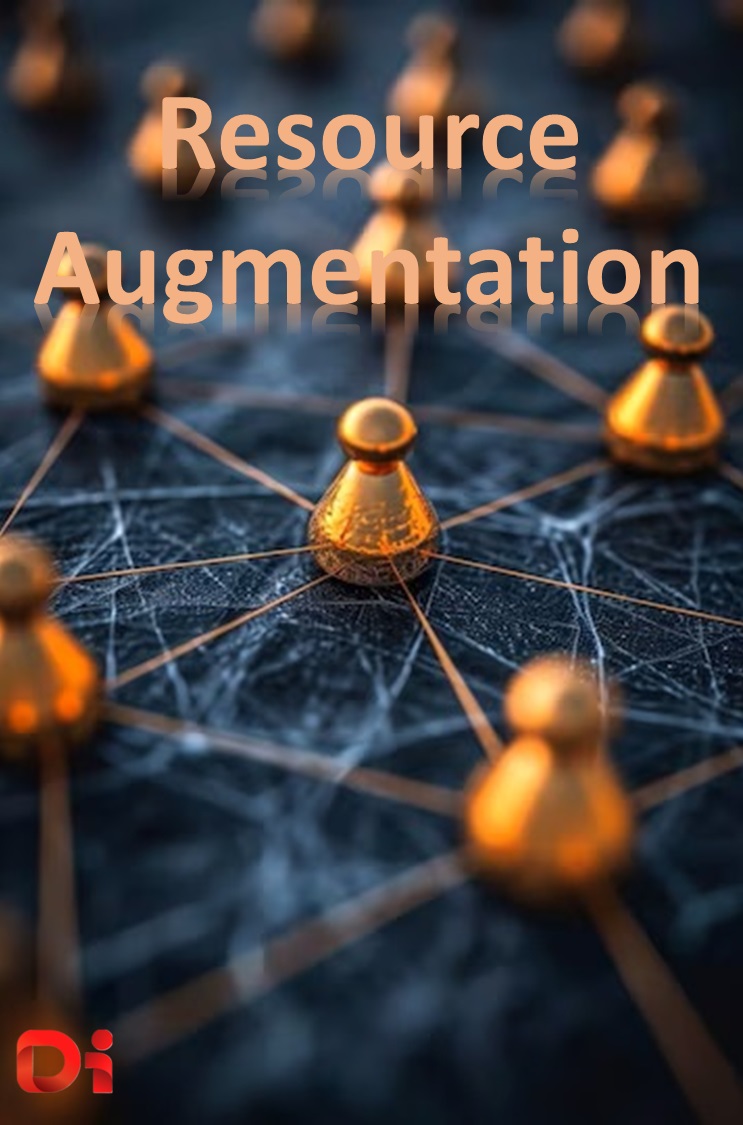

Resource Augmentation is the process of increasing the resources available to an organization to improve its performance or capabilities. This can include adding physical resources such as equipment or personnel, increasing access to financial resources, or investing in new technology.
The goal of resource augmentation is typical to improve efficiency, productivity, or competitiveness. This process is often used in situations where an organization needs to expand its operations, improve its performance, or respond to changes in the market or industry. It can also be used to address specific issues such as a lack of skills or expertise

within the organization. Resource augmentation is a key aspect of organizational development and management and can help organizations achieve their goals and remain competitive in an ever-changing business environment.
In project management, resource augmentation refers to reallocating or adding resources to a project to ensure its successful completion within budget and time constraints. This could involve reallocating personnel, securing additional funding, or acquiring specialized equipment or expertise.
Overall, resource augmentation plays a crucial role in optimizing resource utilization and enhancing the overall performance of systems, organizations, and projects. By strategically allocating resources and scaling them as needed, businesses can adapt to changing demands, improve productivity, and maintain a competitive edge in their respective industries.
.jpg)
1. Staff augmentation: Hiring external talent on a temporary basis to supplement existing teams or fill skill gaps is beneficial when there's a short-term need for specialised skills or added manpower to complete a project within tight deadlines.
2. Technology augmentation: Integrating new technologies or upgrading existing systems enhances operational efficiency, vital when outdated systems hinder productivity or when adopting new technologies can lead to significant performance improvements.
3. Infrastructure augmentation: Expanding or upgrading physical assets such as facilities, equipment, or networks is necessary when existing infrastructure constraints limit scalability, hinder performance, or compromise safety standards.
4. Knowledge augmentation: Acquiring external expertise, training employees, or using knowledge-sharing platforms to enhance skills and competencies is crucial when organisations face skill gaps, require specialised knowledge, or aim to foster a culture of continuous learning.
5. Process augmentation: Optimising workflows and procedures to maximise efficiency and effectiveness involves identifying and eliminating bottlenecks, streamlining operations, and implementing best practices to achieve better results with existing resources.
1. Flexibility: Scaling the workforce, technology, or infrastructure up or down based on demand allows organisations to respond quickly to changing market conditions and business needs.
2. Cost efficiency: Leveraging external resources reduces costs associated with hiring and maintaining in-house staff, purchasing and maintaining technology infrastructure, and investing in specialised expertise.
3. Access to specialised skills and expertise: Resource Augmentation provides access to specialised skills and expertise that may not be available internally, tapping into a broader talent pool to meet specific needs.
4. Time savings: Outsourcing specific tasks or projects to external providers saves time on recruitment, training, and project management, allowing internal teams to focus on strategic initiatives and core business activities.
5. Scalability: Scaling operations quickly and efficiently without major disruptions to the business allows organisations to ramp up production, expand customer support capabilities, or implement new technologies as needed.
6. Focus on core competencies: Outsourcing non-core functions allows organisations to focus resources on activities that directly contribute to core competencies and competitive advantage, leading to increased innovation, product development, and customer satisfaction.
7. Risk mitigation: Diversifying sources of expertise and resources helps mitigate various risks, including talent shortages, technology obsolescence, regulatory compliance, and market fluctuations.

8. Enhanced quality and efficiency: External providers often deliver high-quality results efficiently, improving the quality, accuracy, and speed of operations through their specialised capabilities.
9. Access to advanced technology: Resource Augmentation enables access to cutting-edge technologies and tools without significant upfront investments, helping organisations stay competitive and innovative.
10. Global reach: Leveraging resources from different regions and countries enables organisations to expand reach, diversify customer base, and capitalise on emerging opportunities in international market
3. Infrastructure augmentation: Expanding or upgrading physical assets such as facilities, equipment, or networks is necessary when existing infrastructure constraints limit scalability, hinder performance, or compromise safety standards.
4. Knowledge augmentation: Acquiring external expertise, training employees, or using knowledge-sharing platforms to enhance skills and competencies is crucial when organisations face skill gaps, require specialised knowledge, or aim to foster a culture of continuous learning.
5. Process augmentation: Optimising workflows and procedures to maximise efficiency and effectiveness involves identifying and eliminating bottlenecks, streamlining operations, and implementing best practices to achieve better results with existing resources.
1. Thorough vendor selection: Conduct comprehensive research, evaluate reputation and experience, and seek references to ensure reliability and performance.
2. Clear Service Level Agreements (SLAs): Develop detailed slas outlining expectations, deliverables, and quality standards to ensure alignment with organisational goals.
3. Effective communication and collaboration: Establish open communication channels, conduct regular meetings, and address concerns promptly to prevent misunderstandings.
4. Risk management and contingency planning: Identify potential risks, develop mitigation strategies, and establish protocols for handling unexpected events.
5. Data security and compliance measures: Prioritise data security, conduct regular audits, and implement encryption and access controls to ensure compliance.
6. Transition and knowledge transfer: Plan structured transition processes, provide comprehensive documentation and training, and clarify roles and responsibilities for continuity.
7. Continuous monitoring and performance management: Monitor partner performance, implement real-time monitoring mechanisms, and take proactive corrective actions.
8. Legal and contractual safeguards: Draft comprehensive contracts defining rights and obligations, including provisions for termination and dispute resolution.
Looking to quickly fill skill gaps, enhance your technology, or expand your resources? Our Resource Augmentation services provide flexible, cost-effective solutions tailored to your business needs. Contact us now to discover how we can strengthen your team and accelerate your projects.
Contact Us209 Carlingford, Sydney, New South Wales, Australia
info@dataintence.com
© 2026 | Data Intence Technology Pty Ltd